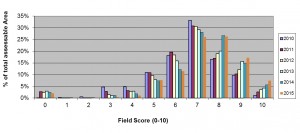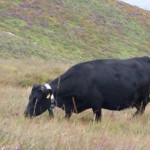This project seeks to develop evidence-based management recommendations for the…
Burren LIFE: Farming for Conservation
The Burren region, located between Counties Clare and Galway, is a place which has long been recognised for its unusual rocky landscape, its rich wildlife and its fascinating archaeology. As with much of the Irish landscape, the Burren has been shaped over many millennia by the actions of farmers and their livestock. Supporting these farmers to sustain low-input grazing systems is a key challenge if we are to ensure the Burren maintains its exceptional natural and cultural heritage. Burren Life is a locally targeted conservation programme which tries to meet this challenge, using a novel approach which places farmers at the very centre of the conservation agenda and rewarding these farmers for their environmental performance. With 15,000ha currently under management, Burren Life has proven to be very impactful and has received much recognition in recent times for its work.
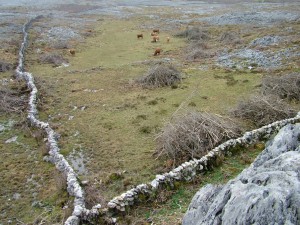
This perhaps belies the fact that the model is based on over 10 years of applied, farm-level research and relationship-building. The initial spark for Burren Life came from a number of local actors, most importantly farmers who felt their voices were not being heard when Special Areas of Conservation were being designated on, and Agri-environment schemes designed for, their land. A 3 year, Teagasc-funded research project ensued which told the full story of farming and the Burren, highlighting the threats posed by recent changes in farming, but emphasising that farming and environmental lobbies had more in common than was recognised. This research provided the impetus for the National Parks and Wildlife Service, Teagasc and the Burren Irish Farmers Association to come together in support of an EU-LIFE funded project aimed at developing a blueprint for sustainable farming in the region.
This 5 year research project, again conducted at farm level in the Burren with the full involvement of local farmers, showed a way forward which could accommodate all stakeholder interests. With appropriate scientific input from a local project team, and based on lessons learned from the local research, a bespoke model to incentivise farmers to improve the environmental health of their farm was developed. Using this model, funded by the Department of Agriculture, Food and the Marine and the National Parks and Wildlife Service, the Burren Life Programme (2010-2015) was introduced, its subsequent success built on the solid foundations of strong local ownership and pride, effective working partnerships, and practical science. How does Burren Life operate? Burren Life uses a novel hybrid approach to farming for conservation which sees farmers paid for both work undertaken and, most importantly, for the delivery of defined environmental objectives. Within Burren Life, farmers are helped to prepare their own simple farm plan (most only 3 pages and very visual) each year by their trained advisor and the Burren Life team.
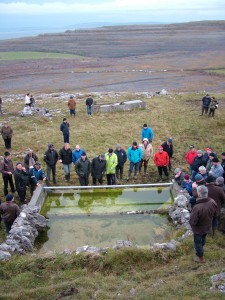
The plan is tailored to suit the needs of the individual farm and outlines the two payment categories:
1. Payment for Actions
The annual farm plan contains a list of actions (jobs) which are nominated by the farmer with the aim of improving the sites management and conservation condition. Each job is individually costed and co-funded by the farmer, and is carried out within the year by the farmer and/or a local contractor. Payment issues only when jobs are completed, and to a satisfactory standard. The farmer can opt-out of a planned action if he/she so chooses, ensuring maximum flexibility for the farmer. Most farms nominate a mixture of jobs to suit the needs of their land e.g. removing encroaching scrub from species-rich grassland, repairing internal walls or enhancing access. Protecting natural water sources and gathering, storing and supplying clean water are among some of the most popular jobs undertaken. Work completed over the first 6 years of the Burren Life Programme includes: 241ha of scrub (mainly hazel and blackthorn) removed across a wide area of the Burren 164km of (c.3m wide) stock paths opened through scrub to reconnect areas of grazing 112km of broken wall (gaps!) repaired and 720 new gates fitted 440 new watering points installed and scores of sensitive springs protected 55km of vehicle access tracks repaired or created, enabling improved long-term management
2. Payment for Results
Every eligible field of species-rich Burren grassland and heath is assessed annually with a user-friendly habitat health checklist (one criterion used is the condition of the natural water sources in the field, for example). Each field receives a score between 1 and 10: all fields with a score greater than 3 receive payment but higher scores receive higher payments. This gives farmers the incentive to manage their fields in ways that will improve their scores and their payment as well. The results-based payment system allows farmers greater freedom to decide how to manage their land (with advice if needed) and also guarantees the taxpayer better value for money i.e. no delivery, no payment! It also generates data (see table below) which demonstrates the positive environmental impact of Burren Life. This graph shows that, between 2010 and 2015, the area of Burren grassland in very good condition (scoring >7) increased and the area in poorer condition (scoring <7) decreased.
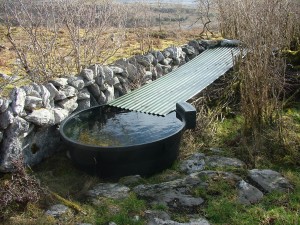
Impact of Burren Life
Over the course of the first 6 years (2010-2015), Burren Life has had major environmental and socio-economic impacts in the Burren. 5.9m has been invested directly in the region, with an average of 6,500 per year going to each farmer, with the added benefit that much of this money is recycled locally. Farmers themselves have invested an additional 1.6m in the programme through co-funding of farm works, amounting to a total spend of 7.5m.
This funding has contributed to a number of spin-offs such as increased work for local contractors, more custom for local shops and manufacturers (e.g. Burren gates), and new farm-based tourism enterprises. Burren Life has delivered a range of proven environmental benefits on about 14,500ha of prime Burren habitat. It has cemented strong partnerships between farmers and management agencies, helped to create a very positive attitude towards conservation among farmers, and has generated a far greater appreciation of the role of farmers by the wider community. Through this work, Burren Life has made a very meaningful and lasting contribution to the future of Irelands most extraordinary landscape, the Burren. The success of the programme has contributed to the introduction of a new 70m measure for Locally-led Agri Environment Schemes in the Rural Development Programme 2015-2020, which includes an expansion of the programme across the entire Burren (30,000ha target area) with an estimated annual budget of 3-4m.
